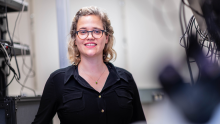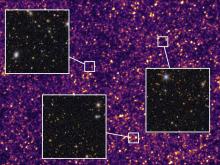New number crunching by UBC researchers strongly refutes recent theories that propose the Earth holds a central position in the Universe.
Advanced analysis and modeling by Physics and Astronomy post-docs Jim Zibin and Adam Moss and astronomy professor Douglas Scott have debunked 'void theory'—a recent proposal that challenges the Copernican Principle.
"Since we can only observe the Universe from Earth, it's really hard to determine if we're in a special place," says Zibin. "But we've now learned that our location is much more ordinary than the strange dark energy that fills the Universe."
Polish astronomer Nicolaus Copernicus argued in 1543 that the Earth was just another planet orbiting the Sun—not the centre of the then-known Universe. Since, astronomers have extended the idea, arguing that our place in the Universe as a whole is also completely ordinary. Although the so-called Copernican Principle has become a pillar of modern cosmology, establishing it conclusively has proven difficult.
In 1998, studies of distant explosions indicated that the expansion of the Universe is accelerating, an observation attributed to the repulsive force of mysterious 'dark energy.' However, some scientists put forward an alternate theory. They proposed that the Earth was near the centre of a giant void mostly empty of matter, putting Earth back in the middle of things.
"We tested void models against the latest data, including subtle features in the cosmic microwave background radiation–the afterglow of the Big Bang–and ripples in the large-scale distribution of matter," says Zibin. "We found that void models do a very poor job of explaining the combination of these data."
The researchers used data from the Wilkinson Microwave Anisotropy Probe satellite, which includes members from UBC on its international team, as well as data from various ground-based instruments and surveys. The findings are published in Physical Review Letters.
The team's calculations instead solidify the conventional view that an enigmatic dark energy fills the cosmos and is responsible for the acceleration of the Universe.
"Recent advances in data collection have brought us to the era of precision cosmology," says Zibin. "Void models are terrible at explaining the new data, but the standard dark energy model works very well."
Musqueam First Nation land acknowledegement
We honour xwməθkwəy̓ əm (Musqueam) on whose ancestral, unceded territory UBC Vancouver is situated. UBC Science is committed to building meaningful relationships with Indigenous peoples so we can advance Reconciliation and ensure traditional ways of knowing enrich our teaching and research.
Learn more: Musqueam First Nation
Faculty of Science
Office of the Dean, Earth Sciences Building2178–2207 Main Mall
Vancouver, BC Canada
V6T 1Z4


